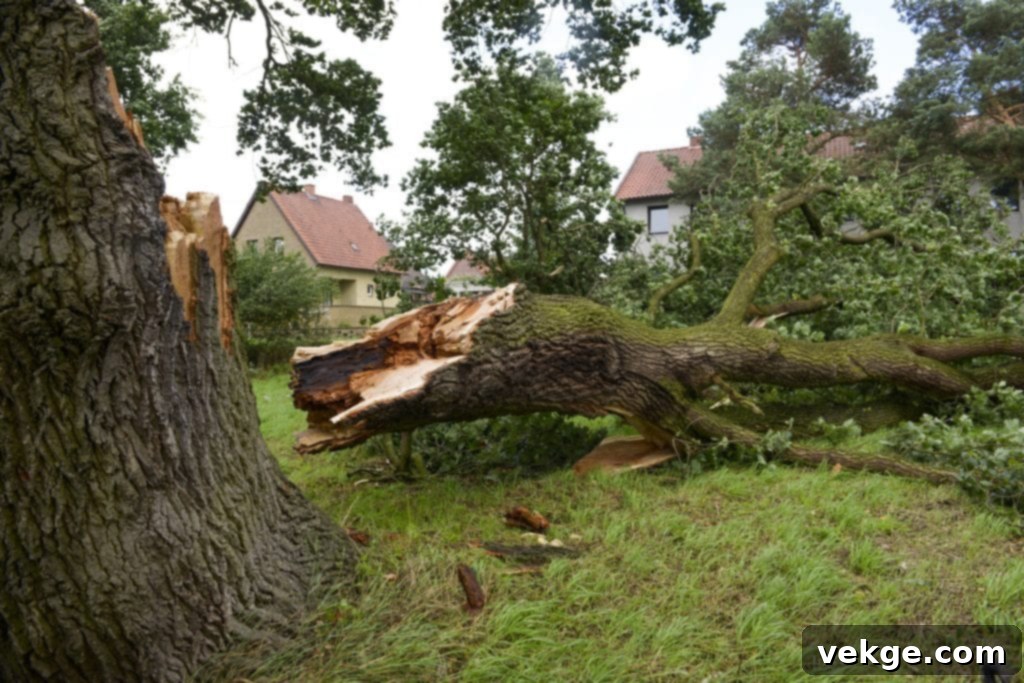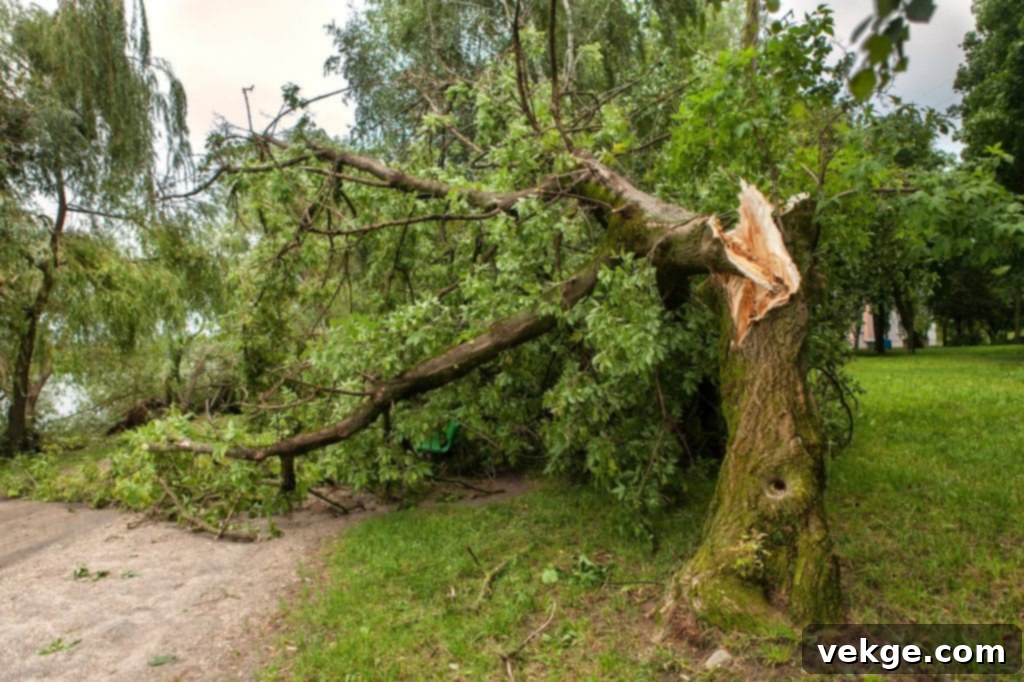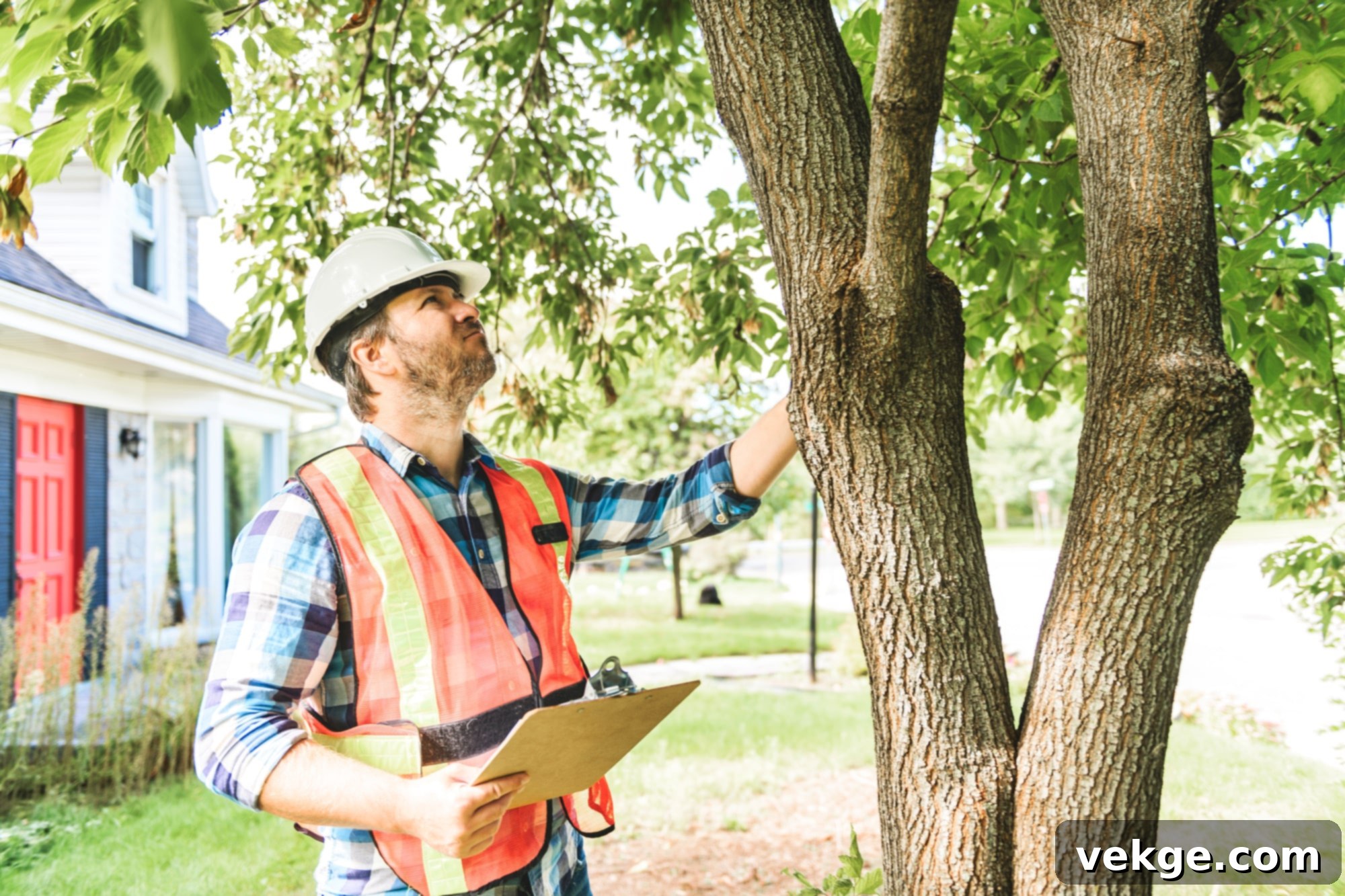Post-Storm Tree Care: Essential Dos and Don’ts for Tree Recovery and Resilience
Storms can unleash unpredictable chaos, transforming serene landscapes into scenes of disarray. Our majestic trees, often the silent sentinels of our homes and communities, bear the brunt of this fury, emerging battered, vulnerable, and sometimes precariously damaged. The sight of twisted branches, fallen limbs, or even uprooted giants can be disheartening, hinting at the extensive damage beneath the surface. Yet, amidst this turmoil, there’s a powerful message of hope and resilience, coupled with a clear path forward for effective recovery.
This comprehensive guide is your essential companion, delving into the crucial dos and don’ts of tree care after storm damage. It’s designed to empower you with the knowledge and practical steps needed to navigate these challenging times, ensuring your trees not only survive the immediate aftermath but also continue to thrive and stand tall for years to come. From safely assessing the extent of the damage to understanding the nuances of when and how to prune, we’ll walk you through each vital step with care and clarity. Your trees have weathered the storm, showcasing their inherent strength. Now, it’s our collective turn to support them in their recovery journey.
Let’s embark on this journey together, transforming post-storm despair into informed, effective action for our cherished leafy friends, fostering a landscape that is both beautiful and robust.
Do Inspect for Damage Safely and Thoroughly

After the immediate danger of a storm has passed, conducting a meticulous and safe inspection of your trees is a foundational step you absolutely cannot skip in the journey of post-storm tree care. Begin your assessment from the ground up, paying close attention to the base of the tree. Look for signs of upheaval such as loose soil around the trunk or exposed roots, which are critical indicators of a compromised and potentially shaky foundation. These issues can signify that the tree’s anchoring system has been weakened, making it susceptible to future instability or even complete failure.
Next, meticulously scan the trunk and branches for any visible breaks, tears, or splits. These are unequivocal signs that your trees have sustained injury and are in distress. Pay particular attention to the integrity of branch attachments. Small cracks in the bark, though seemingly minor, should never be ignored; they can evolve into significant entry points for pests and diseases, compromising the tree’s long-term health. For damage that’s high up and out of reach, a pair of binoculars can be an invaluable tool, allowing for a safe and detailed peek at potential troubles without risking personal safety. This careful, systematic check-up provides a comprehensive understanding of the storm’s impact on your trees, laying the groundwork for their effective comeback and ensuring you address all levels of damage. Documenting your findings with photos can also be beneficial for insurance claims or when consulting with professionals. This careful check-up not only helps you understand what your trees are going through but also sets the stage for their robust comeback.
Don’t Rush to Prune: Understand Tree Resilience and Natural Healing
Following a storm, the sight of jagged, broken branches can be distressing, and you might feel an overwhelming urge to immediately grab your pruning shears and start cutting away the damaged parts. However, in most cases, this immediate, knee-jerk reaction is best avoided. While your intentions may be good, rushing to prune can often do more harm than good to a tree that is already under immense stress.
Trees possess an incredible, inherent resilience and a remarkable capacity for self-repair. They are not like humans or animals that heal wounds by regenerating tissue. Instead, trees employ a process called “compartmentalization,” where they form protective barriers around injured areas to seal off decay and prevent further spread. Immediate, unthoughtful pruning can inadvertently remove branches that could have healed naturally or even healthy tissue crucial for the tree’s recovery. Worse yet, it can create fresh, open wounds in vulnerable areas, which, rather than aiding recovery, can become prime entry points for destructive pests and various diseases, severely setting back the tree’s healing process.
Instead, the best course of action is to give your trees a grace period—a few days to a week—to assess the full extent of the damage and allow their natural healing mechanisms to begin. During this time, you can clearly distinguish between truly dead or severely broken branches that pose an immediate hazard and those that might still recover. Patience now is not inaction; it’s a strategic choice that can mean the difference between a tree that struggles to cope with new injuries and one that bounces back stronger, healthier, and more resilient. Only after careful consideration and identification of genuinely irreparable or hazardous limbs should you consider pruning, ideally with the guidance of an expert.
Do Seek Professional Arborist Help for Significant or Hazardous Damage
While some minor tree damage might be manageable for a homeowner, many storm-related issues transcend the scope of DIY care. For extensive damage, large broken limbs, or any tree that appears unstable or potentially hazardous, your trees unequivocally need more than just a friendly hand—they require the specialized expertise of professional arborists. Reaching out to certified tree care specialists like Avalon Tree isn’t an admission of defeat; it’s a smart, responsible, and often critical move to ensure safety and the best possible outcome for your trees.
These trained professionals possess an unparalleled understanding of tree biology, structure, and health. They come equipped not only with advanced tools and machinery to safely access and remove large, dangerous branches but also with the profound knowledge to accurately diagnose problems and determine whether a severely damaged tree can be saved or if its removal is the safest option. Think of them as dedicated tree doctors who can assess the structural integrity of your trees, identify hidden damage, and prescribe the most effective and safe treatments, whether it involves precise pruning, cabling and bracing for weakened limbs, or strategic removal of beyond-saving trees. Their intervention can significantly mitigate risks to your property and family, and it can be the pivotal difference between a tree’s full recovery and its untimely loss. By entrusting your green giants to qualified specialists, you’re investing in their longevity and ensuring they can continue to stand tall and healthy for many years to come. So, never hesitate to call in the experts; it’s a vital, proactive step in your comprehensive tree care journey after a storm.
Don’t Neglect Post-Storm Hydration and Mulching: Fueling Recovery

In the aftermath of a storm, trees are akin to athletes who have just completed an arduous marathon—they are exhausted, profoundly thirsty, and in desperate need of attentive care to regain their strength. Therefore, it’s absolutely crucial not to overlook their fundamental need for adequate water and the protective benefits of mulch. Even if a storm brought heavy rainfall, the intense winds and sudden changes in conditions can severely stress a tree’s root system, impairing its ability to absorb moisture efficiently. A thorough and deep watering helps them bounce back, rehydrating roots that may have been compromised or simply dehydrated by the storm’s environmental extremes.
Meanwhile, applying a generous blanket of organic mulch around the base of your trees acts like a soothing, nutrient-rich balm. Mulch is a multi-functional hero in post-storm recovery. It significantly helps in retaining soil moisture, reducing the need for frequent watering, and ensuring a consistent supply of hydration to the stressed roots. Furthermore, mulch acts as an insulator, keeping the soil cooler on hot days and warmer during unexpected cold snaps, which helps regulate root zone temperatures. As it slowly breaks down, organic mulch steadily releases vital nutrients back into the soil, feeding the tree as it works to repair itself. It also suppresses competing weeds and protects the tender bark from damage by lawnmowers or string trimmers. This simple, yet incredibly effective, act of providing proper hydration and mulching can make a monumental difference in their post-storm healing process, laying a strong foundation for their long-term health and vitality.
Do Watch for Diseases and Pests: Tree Vulnerability Post-Storm
After a storm, your trees are more than just physically shaken; they are critically exposed and profoundly vulnerable to external threats. Think of their broken branches, torn bark, and compromised structural integrity as wide-open doors inviting unwanted and opportunistic guests. Diseases and pests, ever-vigilant, perceive an opportunity where we see damage—a weakened host is an easy target. That’s precisely why maintaining a vigilant eye on your storm-damaged trees for any signs of infestation or infection is absolutely crucial.
Storm-related injuries, such as bark wounds or snapped limbs, can create ideal entry points for fungal spores, bacterial infections, and a multitude of insects. These invaders can quickly exploit the tree’s reduced defenses, hindering its recovery and potentially leading to more severe health issues or even death. Spotting unusual leaf discoloration, premature wilting, the presence of boreholes, sawdust-like frass, or unexpected insect activity (like swarms of beetles or webs) early on can be the ultimate determinant in saving your tree. Regular, attentive checks allow for timely detection. Early identification and prompt action—whether it’s applying appropriate treatments, consulting an arborist, or implementing cultural practices—are your best lines of defense. In this critical period, your role as the tree’s caretaker is more vital than ever, as your vigilance directly contributes to helping your trees heal and successfully ward off these insidious invaders, ensuring their enduring health and beauty.
Don’t Use Tourniquets or Wraps on Tree Wounds: Trust Natural Healing
It’s a natural, compassionate instinct to want to “bandage” a tree’s wounds, similar to how we would treat a scrape or cut on ourselves. You might be tempted to wrap injured branches or trunks with tape, cloth, or other materials, believing you’re providing protection and aiding healing. However, it’s crucial to understand that trees are biologically distinct from humans and heal in a fundamentally different way. Applying tourniquets, tree wraps, or wound dressings is generally counterproductive and often detrimental to a tree’s recovery.
When you cover a tree’s wounds with restrictive wraps or impervious materials, you inadvertently hinder its natural healing processes. These coverings can trap excessive moisture against the bark, creating a warm, damp environment that is an ideal breeding ground for harmful fungi, bacteria, and decay organisms. Instead of promoting healing, this trapped moisture can accelerate rot and disease development, making the wound worse and weakening the tree further. Furthermore, tight wraps can constrict the cambium layer, the living tissue responsible for growth and nutrient transport, effectively girdling the tree or branch and impeding its ability to send vital resources past the injured area.
Trees do not “heal” in the way humans do by regenerating skin over a wound. Instead, they “seal” off injuries through a remarkable process called “compartmentalization of decay in trees” (CODIT). They grow new wood and bark over and around the wound, forming a protective barrier (a callus) to wall off the damaged area and prevent the spread of decay into healthy tissue. This process requires good air circulation and the absence of trapped moisture. Therefore, the best approach for a tree wound is to ensure a clean, smooth cut (if pruning is necessary), remove any ragged edges, and then leave it exposed to the air. This allows the tree to perform its natural compartmentalization unimpeded, effectively sealing out pests and diseases on its own. Trust in their natural resilience; if a tree is hurt, provide it with proper care like watering and mulching, and give it the space to do its thing. It will thank you by thriving, stronger and more robust, without the need for unnecessary bandages.
Do Develop a Long-Term Recovery Plan
The immediate aftermath of a storm demands quick, decisive action, but true tree recovery extends far beyond the initial cleanup and damage assessment. To ensure the lasting health and resilience of your trees, it’s essential to develop and commit to a long-term recovery plan. This strategy encompasses ongoing monitoring, proactive care, and professional follow-up, transforming short-term efforts into sustainable benefits.
Firstly, consistent monitoring is key. Regularly inspect your trees for any delayed signs of stress, pest infestations, or disease that might emerge weeks or months after the storm. Watch for changes in leaf color, new signs of decay, or unusual growths. Secondly, continue to provide optimal growing conditions. This includes maintaining proper watering schedules, especially during dry spells, and replenishing mulch to support soil health. While immediate fertilization is generally not recommended as it can stress an already weakened tree, a certified arborist might suggest specific soil amendments or a gentle, slow-release fertilizer in the longer term to boost recovery, but only after careful assessment. Third, consider the long-term structural integrity. For trees that have suffered significant branch loss or structural damage, a professional arborist may recommend cabling or bracing to support weakened limbs and prevent future failures. These preventative measures, when applied correctly, can significantly extend a tree’s life and enhance its safety. Finally, schedule annual check-ups with your arborist. These routine inspections allow professionals to identify potential issues early, perform necessary maintenance pruning, and adjust your care plan as your trees continue to recover and grow. A comprehensive, long-term approach ensures that your green canopy not only heals but flourishes, becoming more resilient against future environmental challenges.
Final Thoughts: Nurturing Your Trees Back to Health
The journey of post-storm tree recovery can seem daunting, but with the right knowledge and a proactive approach, your trees have an excellent chance of not just surviving, but truly flourishing again. Remember, your vigilance and informed actions are the greatest assets in helping your green giants regain their strength and beauty. Start by safely assessing the damage, understanding the nuanced timing for intervention, and never hesitating to call upon the invaluable expertise of certified arborists for significant issues.
Beyond the initial care, commit to the ongoing practices of proper hydration and mulching, recognizing these as fundamental pillars of tree health. Remain vigilant for the insidious threats of diseases and pests, which often capitalize on a tree’s weakened state. Most importantly, resist the urge to apply well-intentioned but harmful treatments like wound wraps, trusting in the tree’s extraordinary natural capacity for compartmentalization and self-protection. By developing a thoughtful, long-term recovery plan, you ensure that your efforts today contribute to a resilient and vibrant landscape for years to come.
Every mindful step you take breathes life back into your green canopy, fostering not just recovery but renewed vitality. Your journey to cultivating resilient greenery, a testament to nature’s enduring strength and your dedicated care, starts now. Let’s nurture our trees back to their magnificent glory!
